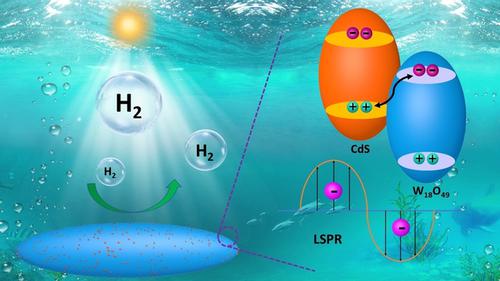当前位置:
X-MOL 学术
›
ChemNanoMat
›
论文详情
Our official English website, www.x-mol.net, welcomes your
feedback! (Note: you will need to create a separate account there.)
Oxygen Vacancies Induced Plasmonic Effect for Realizing Broad‐Spectrum‐Driven Photocatalytic H2 Evolution over an S‐Scheme CdS/W18O49 Heterojunction
ChemNanoMat ( IF 2.6 ) Pub Date : 2020-10-26 , DOI: 10.1002/cnma.202000536 Qinqin Liu 1 , Xudong He 1 , Junnan Tao 1 , Hua Tang 1 , Zhao‐Qing Liu 2
ChemNanoMat ( IF 2.6 ) Pub Date : 2020-10-26 , DOI: 10.1002/cnma.202000536 Qinqin Liu 1 , Xudong He 1 , Junnan Tao 1 , Hua Tang 1 , Zhao‐Qing Liu 2
Affiliation

|
Broad‐spectrum‐driven photocatalysis remains a challenging pursuit for light‐chemical energy conversion. Integrating plasmonic nanostructures with localized surface plasmon resonance (LSPR) effect as light absorber onto photocatalyst can realize broad spectral response as well as promote light to energy conversion. Herein, oxygen‐vacancy‐rich W18O49 as plasmon antenna was coupled with CdS to form an S‐scheme CdS/W18O49 heterojunction demonstrating photocatalytic H2 generation activity under a broad‐spectrum light irradiation. Upon exposure to visible light, the CdS/W18O49 heterojunction illustrates the best photocatalytic H2 generation rate of 5.9 mmol g−1 h−1, which is 2.6 times higher than CdS; and its external quantum efficiency achieves 0.17% and 0.05% at 550 and 650 nm, respectively. This activity enhancement is attributed to the enhanced light‐harvesting ability and faster charge separation induced by the LSPR effect of the W18O49 plasmon with rich oxygen vacancies and S‐scheme transfer mechanism. This work will be beneficial to develop non‐metal plasmons assisted broad‐spectrum‐response photocatalysts.
中文翻译:

氧空位诱导的等离子效应在S方案CdS / W18O49异质结上实现广谱驱动的光催化H2释放
广谱驱动的光催化仍然是光化学能量转换的一项挑战。将具有局部表面等离子体共振(LSPR)效应的等离子体纳米结构作为光吸收剂整合到光催化剂上,可以实现宽光谱响应并促进光到能量的转换。在此,作为等离子体激元天线的富氧空位W 18 O 49与CdS耦合形成S方案CdS / W 18 O 49异质结,表明在广谱光照射下光催化H 2的产生活性。在可见光下,CdS / W 18 O 49异质结显示出最佳的光催化H 2生成速率为5.9 mmol g -1 h -1,是CdS的2.6倍;其外部量子效率在550和650 nm分别达到0.17%和0.05%。这种活性的提高归因于W 18 O 49等离子体激元具有丰富的氧空位和S迁移机制的LSPR效应增强了光捕获能力和更快的电荷分离。这项工作将有助于开发非金属等离子体激元辅助的广谱响应光催化剂。
更新日期:2020-10-26
中文翻译:

氧空位诱导的等离子效应在S方案CdS / W18O49异质结上实现广谱驱动的光催化H2释放
广谱驱动的光催化仍然是光化学能量转换的一项挑战。将具有局部表面等离子体共振(LSPR)效应的等离子体纳米结构作为光吸收剂整合到光催化剂上,可以实现宽光谱响应并促进光到能量的转换。在此,作为等离子体激元天线的富氧空位W 18 O 49与CdS耦合形成S方案CdS / W 18 O 49异质结,表明在广谱光照射下光催化H 2的产生活性。在可见光下,CdS / W 18 O 49异质结显示出最佳的光催化H 2生成速率为5.9 mmol g -1 h -1,是CdS的2.6倍;其外部量子效率在550和650 nm分别达到0.17%和0.05%。这种活性的提高归因于W 18 O 49等离子体激元具有丰富的氧空位和S迁移机制的LSPR效应增强了光捕获能力和更快的电荷分离。这项工作将有助于开发非金属等离子体激元辅助的广谱响应光催化剂。











































 京公网安备 11010802027423号
京公网安备 11010802027423号